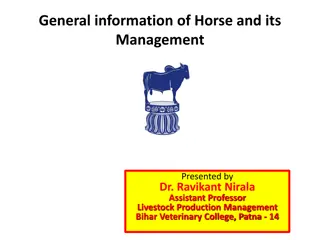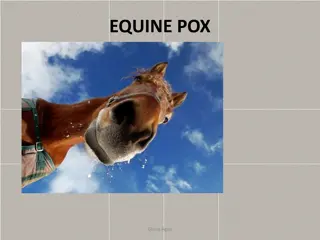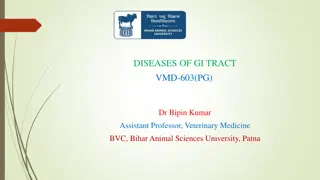Equine colic
Learn about the definition, causes, and types of colic in horses. Discover how to treat and prevent this potentially deadly condition.
0 views • 18 slides
Horse boarding business plan example
Consider a horse boarding business plan as your blueprint for building a sanctuary where horse owners entrust their beloved companions. It's a strategic playbook, detailing services, pricing, target markets, marketing strategies, and financial projections to ensure a thriving venture in the equine w
0 views • 37 slides
Understanding Poll Evil and Yoke Gall in Horses: Symptoms and Treatment
Poll evil and yoke gall are common afflictions affecting horses, particularly in the neck region. Poll evil is an inflammatory condition characterized by a painful swelling at the top of the neck, while yoke gall is localized acute inflammation caused by yoke pressure. Poll evil is typically treated
0 views • 8 slides
Horse Management and Common Terminology Overview
Dr. Ravikant Nirala, Assistant Professor at Bihar Veterinary College, presents comprehensive information on horse management and common terminology associated with equine production. The content covers the position of horses in the animal kingdom, terminology for different horse genders and ages, mi
1 views • 15 slides
Equine Coital Exanthema: Overview, Symptoms, and Management
Equine coital exanthema, caused by Equine Herpesvirus 3, is a contagious venereal disease affecting horses globally. It primarily manifests as genital lesions in stallions and mares, transmitted sexually or through contact with contaminated materials. While it is typically self-limiting, it can be p
0 views • 23 slides
Understanding Strangles in Horses: Symptoms, Treatment, and Complications
Strangles, also known as Equine Distemper, is an infectious disease affecting horses and equids. It is characterized by upper respiratory tract infection, lymph node abscesses, and various complications. Symptoms include nasal discharge, coughing, and swelling of lymph nodes. Prompt diagnosis and tr
3 views • 11 slides
Understanding Impotentia Generandi in Male Animals
Inability or reduced ability to fertilize the ovum due to testis, epididymis, or accessory sex gland pathology is known as Impotentia Generandi. This condition can be associated with normal or abnormal semen production, affecting fertility in male animals. Factors like congenital or acquired defects
0 views • 30 slides
Understanding Impotentia Generandi in Male Animals
Inability or reduced ability to fertilize the ovum due to testicular pathology is known as Impotentia Generandi. It can be associated with abnormal or apparently normal semen production, affecting the fertility of male animals. Conditions such as brucellosis, cryptorchidism, and congenital defects l
0 views • 30 slides
Veterinary Update on Equine Worming Protocols
Explore the latest insights on equine worming practices, including details on common types of worms, clinical signs, prevention, treatment, and diagnostic methods. Learn about dealing with threadworms, tapeworms, pinworms, bots, and lungworms in horses and donkeys.
0 views • 36 slides
Equipment Used for Castration and Testectomy in Food Animals
This informative content illustrates various equipment used for castration and testectomy in food animals. It includes tools like scalpel, castration knife, emasculator, and emasculatome, each serving different purposes in the procedure. The use of these tools ensures efficient and bloodless castrat
0 views • 6 slides
Exploring 4-H Equine Cloverbud Opportunities
Delve into the world of 4-H Equine Cloverbuds where young horse enthusiasts can participate in a variety of activities such as Horse Bowl, County Shows, Western Games, and more. Cloverbuds can engage in the Horseless Horse project to learn about equine care, breeds, grooming, and tack. They can also
0 views • 9 slides
Guidelines for Cleaning and Disinfection in Animal Production Facilities
Explore key guidelines for cleaning and disinfecting various animal production facilities, including poultry, dairy, swine, equine, and aquaculture. Specific challenges and safety considerations for each type of facility are discussed, highlighting the importance of using appropriate products and te
0 views • 18 slides
Equine Euthanasia Guidelines: Best Practices and Considerations
Equine euthanasia and mass depopulation guidelines emphasize humane treatment, efficient methods, and minimizing emotional impact during animal health emergencies. Techniques such as sedation, acceptable injection methods, and handling protocols are outlined to ensure a stress-free transition for eq
3 views • 14 slides
Guidelines for Equine Euthanasia and Mass Depopulation
Guidelines for equine euthanasia and mass depopulation outline transitioning animals painlessly and stress-free during emergencies. The focus is on humane treatment, minimizing stress, and selecting acceptable methods to safeguard the food chain and prevent disease spread. Handling, sedation, and eu
0 views • 14 slides
Basic Equine Wound Care: Understanding and Treatment
Learn about basic equine wound care, including initial steps to take, stages of the healing process, types of wounds, and treatment options. Understand how to assess the severity of wounds and the importance of proper care to prevent complications. This guide provides valuable information for horse
0 views • 11 slides
Kentucky Horse Racing: Supporting Equine Breeding in Kentucky
Kentucky offers various incentive programs to support the breeding of Thoroughbreds and Standardbreds, such as the Kentucky Breeders Incentive Fund and the Kentucky Sire Stakes. These programs provide financial rewards to breeders based on the success of their horses in eligible races. Other equine
2 views • 7 slides
Opportunities for Volunteering with AAEP
Explore various volunteer opportunities with the American Association of Equine Practitioners (AAEP), such as serving on committees, councils, or task forces. Learn about the governance model, committees, and how to get involved through the Volunteer Interest Form. Understand the competitive applica
0 views • 38 slides
History and Vocabulary of Cattle Farming
Explore the rich history of cattle farming, from the introduction of longhorn cattle in America by the Spanish to the importation of European dairy cattle to Jamestown Colony. Learn about various terms and concepts associated with cattle, such as castration, heifer, marbling, and more. Delve into th
0 views • 36 slides
Equine First Aid Essentials: Ohio State University Extension Guide
Ohio State University Extension provides a comprehensive guide on equine first aid, covering topics such as injury prevention, vital signs, emergency procedures, common problems like colic and wounds, and colic prevention measures. The guide emphasizes the importance of knowing your horse, contactin
0 views • 17 slides
Understanding Electrolytes and Their Importance for Trail Equine Athletes
Explore the crucial role of electrolytes for competitive trail equine athletes, including their functions, absorption in the body, sources of loss, and homemade electrolyte formulations. Learn how electrolytes such as sodium, potassium, and chloride are essential for muscle function, intestinal moti
0 views • 22 slides
Anatomy and Blood Supply of the Equine Stomach
The equine stomach is relatively small compared to the horse's body size, with distinct regions such as the cardia, fundus, body, and pyloric region. It is located on the left side of the abdomen, under the ribs. The stomach's blood supply includes branches from the aorta, splenic artery, and hepati
0 views • 23 slides
Pre-Operative Considerations for Equine Castration
Selection of a technique, common agents used to anaesthetize horses, scrubbing procedure, and blocking method are essential pre-operative considerations for equine castration. Closed and half-closed techniques decrease post-operative complications, while various agents can be used for sedation. Prop
0 views • 6 slides
Canine Castration Techniques and Examination Guide
The physical examination of the scrotum, testicles, prepuce, and penis is vital in evaluating for abnormalities. Castration techniques such as open prescrotal castration are detailed, emphasizing the importance of proper procedure and care. Images and step-by-step instructions further illustrate the
0 views • 6 slides
Understanding Embryo Transfer in Mares: Why, When, and How
Embryo transfer in mares is not a decision to be taken lightly, as there are various factors to consider. This process is conducted for reasons like increasing foal production, dealing with infertility in donor mares, and enhancing reproductive efficiency. The process involves synchronization of mar
0 views • 17 slides
Understanding Equine Influenza: An Overview of Respiratory Tract Infections in Horses
Equine influenza is a contagious upper respiratory infection in horses caused by influenza viruses. This article covers the anatomy of the equine respiratory tract, signs, diagnosis, treatment, prevention, and prognosis of equine influenza. It also discusses the histological structure of the respira
0 views • 18 slides
Equine Gastrointestinal Tract Disorders and Dysphagia Overview
This informative content covers various diseases of the gastrointestinal tract in horses, including oral cavity conditions, dysphagia, sialadenitis, and esophageal disorders like choke. It discusses anatomical classifications, causes, clinical manifestations, and treatment approaches for these condi
0 views • 19 slides
Mosquito Monitoring in Maine 2021: Key Findings and Funding Overview
The Maine Center for Disease Control and Prevention conducted mosquito monitoring in 2021 across various counties and towns, testing for West Nile Virus and Eastern Equine Encephalitis. Results showed no positive cases in mosquito pools but identified individuals with arboviral illnesses. Funding ch
0 views • 6 slides
University of Kentucky Equine Programs Overview
The University of Kentucky's equine programs, led by Dr. Nancy Cox and Dr. James MacLeod, are nationally and internationally recognized for their contributions to equine research and education. With a focus on workforce development, the programs offer undergraduate and graduate opportunities in equi
0 views • 9 slides
Economic Impact Analysis of Equine Industry in Marion County
This economic impact analysis focuses on the Equine Industry in Marion County, particularly the Ocala Metropolitan Statistical Area. The study utilized IMPLAN models to determine the annual economic impact, analyzing data from various sources such as surveys with participants and businesses. The rep
0 views • 16 slides
Understanding Equine Parasites: A Comprehensive Guide by Ohio State University Extension
Explore the intricate world of equine parasites with a detailed guide provided by Ohio State University Extension. Learn about internal and external parasites, common signs of infestation, fecal testing techniques, and specific types like strongyles and roundworms. Discover the importance of proper
0 views • 24 slides
Innovative Applications of doForms in Agribusiness
Explore real-world use cases of doForms in the agribusiness sector, including field data collection on a family-owned farm, streamlining inspections on land and sea, managing equine wellness treatments, leveraging technology in agriculture solutions, and facilitating equipment transactions. These ex
0 views • 7 slides
Importance of Mosquito Control for Disease Prevention in Maine
Learn about mosquitoes, their habitats, diseases they can carry, and ways to prevent mosquito bites to protect yourself from diseases such as Eastern Equine Encephalitis (EEE) and West Nile virus in Maine.
0 views • 16 slides
Equine Behavior and Restraint: Understanding and Handling Horses
Discover key insights into equine behavior and restraint techniques for safe handling of horses. Explore topics such as normal behavior, body language cues, flight zones, herding and moving horses, capture and containment methods, and post-handling considerations. Enhance your understanding of equin
0 views • 13 slides
Emasculator Method for Castration in Bulls
The emasculator method for castration in bulls, also known as the Burdizzo method, is a quick and simple technique when performed correctly. Proper equipment cleanliness, restraint, and technique are essential for success. This method involves crushing the spermatic cords to prevent blood flow to th
0 views • 6 slides
Burdizzo Clamp Castration Procedure in Cattle: Advantages, Disadvantages, and Pain Management
The Burdizzo clamp castration procedure involves crushing the spermatic cord to achieve atrophy of the testicles. This method is bloodless, but slow and requires expertise. Proper pain management, including local anesthesia and NSAIDs, is crucial. Regular monitoring and skilled application are neces
0 views • 4 slides
Livestock Skillathon Quiz on Animal Husbandry
Explore your knowledge on livestock management with this quiz covering topics like animal hormones, castration methods, ideal weights for market steers, drug withdrawal times, and more. Test your understanding of livestock terminology and practices in this engaging quiz.
0 views • 12 slides
Transitioning Away from Surgical Castration of Piglets in European Agriculture
Presentations and discussions from recent webinars highlighted the irreversible shift towards alternatives to surgical castration of male piglets in Europe. While challenges exist, including the need for market acceptance based on boar taint and fat quality, proactive measures such as genetics, feed
1 views • 12 slides
Rational Management of Metastatic Castration-Resistant Prostate Cancer: Treatment Insights and Options
Experts discussed various treatment options for a 60-year-old patient with mCRPC, including switching to Lutetium therapy after progression on Apalutamide. Genetic testing, avoiding back-to-back hormonal therapies, and considering novel AR-blockers like Lutetium-PSMA and PARP inhibitors were highlig
0 views • 6 slides
HERO Phase 3 Trial Results: Relugolix vs. Leuprolide for Prostate Cancer
The HERO study compared the efficacy of oral GnRH receptor antagonist, Relugolix, with the commonly used ADT, Leuprolide Acetate, in treating advanced prostate cancer. Results showed that Relugolix achieved sustained castration more effectively than Leuprolide, with superior testosterone suppression
0 views • 29 slides
Equine Venereal Diseases: Diagnosis and Treatment Overview by Jrme PONTHIER DVM
Learn about the diagnosis and treatment of equine venereal diseases such as Taylorella equigenitalis in horses. Understand the pathogenesis, transmission, and legal obligations for these diseases in the UE (European Union). Discover the general approaches for diagnosis and treatment in stallions and
0 views • 17 slides







































